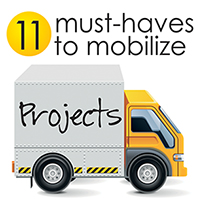Executives today look for project managers who can set up and mobilize a project quickly before it starts. In the past, it could take weeks or months to set up files, directory structures, tools and templates; meanwhile, the project begins before the tools are set up. In order to stand out against others and win project opportunities, there are eleven critical elements to managing projects that executives look for.
- You must have a project dashboard. It’s critical for you as well as team members, executives, stakeholders and shareholders to be able to access a project dashboard and see the status of a project.
- You need a project planning tool or mechanism to plan the tasks, activities and resources in place before the project begins.
- You need a mechanism to track time. One thing over budget projects have in common is that resources do not track time appropriately, primarily because they do not have an easy mechanism in place to do so. Hence, they don’t track time at all until the end, at which point they must guess at what really happened.
- You must have a mechanism in place to track expenses. The devil is in the details! Again, this is one area that is often overlooked and put off until the end of the project. We know that people travel, have meetings and may have ad-hoc expenses, so have a mechanism in place for people to submit expenses in real-time.
- You need a process in place to track risk, issues and changes, so that when the project begins and issues occur you are ready to handle them.
- You should have a project reporting tool in place so that you and everyone else can more readily track progress and know what the needs are.
- Online storage is a must. It’s important to have a central repository for managing project deliverables whether those are project files, plans, processes or assets. When people start coming on board as early as the planning stage and are creating documents, they need to know where to access, manage and maintain that documentation.
- You need to be web-based. Team members today are collocated, in other words, people are working together over the internet. They are in different buildings, cities or even international. Teams need tools that are web-based to be able to access tools and templates by internet.
- Use Microsoft Project as your scheduling tool, as it still has one of the largest market shares in project management software. A lot of teams have access to the software because it’s loaded onto their workplace desktop. You need to be able to interact with Microsoft Project, to know how to export information out of it and into an Excel spreadsheet and to share it with other people.
- Use project collaboration, or knowing what tools your team is going to use to collaborate. People who review and approve documents need a mechanism to collaborate with others online.
- Establish security. All companies worry about the security of their information, so know in advance how you will keep documents secure. Believe it or not, some people still keep paper files in cabinets; if that’s the case with your project, secure those as well. If critical data is online, have the security in place to protect the information from being accessible to different people and groups.
Having these eleven elements in place prior to a project will ensure you maximize your ability to mobilize a project. If you are scrambling to get things set up once the project begins it just causes more chaos. These eleven elements should also help you evaluate what your software needs are. Many tools today incorporate all or some of these elements, so make sure you invest in tools that can accommodate these needs.
Jennifer Whitt, PMP is a speaker, trainer, Certified Performance Coach, author, and company president of PDUs2Go.com. She is a PMI-certified Project Management Professional (PMP) and knows how difficult it can be to make time for classroom or online learning so she has developed a new way for Project Managers to Earn n’ Learn while on the go. For more information, please visit pdus2go



